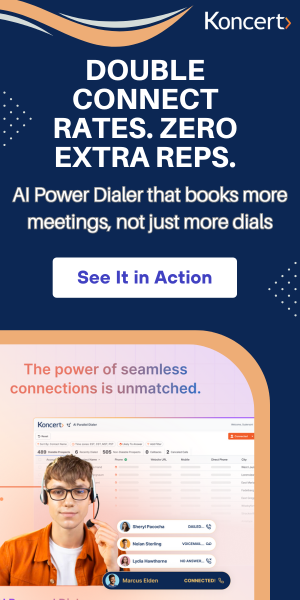9 min read
How to Research and Target High-Potential Prospect Accounts
By: Koncert Marketing on Sep 21, 2023 9:30:00 AM

In outbound sales, success starts with understanding who you should be speaking with in the first place. Sales teams that only work from unsegmented lead lists are essentially playing dartboard prospecting.
To efficiently create pipeline, you need to strategically identify and target high-potential accounts worth pursuing. This requires research, insight, and a sound methodology as listed below.
- Crafting ideal customer profiles
- Identifying total addressable market
- Performing account research
- Scoring and tiering target accounts
- Building targeted call lists
- Conducting account-based outreach
- Managing research and calling in CRM
- Continuous optimization
Craft Detailed Ideal Customer Profiles
The foundation for any account targeting is having clear definitions of your ideal customers. This allows qualifying inbound leads and focusing outbound efforts on the right targets. Ideal customer profiles (ICPs) outline your best-fit buyer including
- Firmographic traits like industry, size, location
- Technology used like software, tools, platforms
- Business challenges, pain points, and goals
- Stakeholders involved in decisions
- Purchasing needs, motivations, and process
Develop ICPs for both company and contact levels. As reviewed in the Attrock curated list, b2b marketing tools like HubSpot, OptinMonster, and others can help you research and define your target audience for targeted marketing campaigns. Leverage your current customer base data to find commonalities and patterns in who sees the most value in your offering.
Detailed ICPs segment targets so you avoid wasting time on low-potential prospects unlikely to buy. They also inform sales targeting and messaging strategy. Leveraging digital marketing solutions can make this process even more effective by helping you deliver personalized content, automate outreach, and analyze engagement at scale.
Define Your Total Addressable Market
With ICPs set, you can Identify your total addressable market (TAM) - the full universe of prospects that fit your ideal customer criteria. TAM sizing uses firmographic data on potential companies in your ICPs across parameters like
- Industry verticals and sub-verticals
- Geo regions and cities
- Company size by employees and revenue
While TAM may be extensive, it gives you a directional sense of prospect penetration potential. You can pursue a small fraction of the TAM and drive substantial business growth.
Prioritize and Tier Target Accounts
While you now know your universe of potential prospects in the TAM, not all are equal. Further prioritization brings the best-fit accounts into focus. Tier accounts using additional attributes like
- Technology used and pain points - Assess product-market fit
- Recent funding, news, job postings - Signs of growth potential
- Online signals of need - Website activities, content interests
- 1st vs. 2nd degree connections - Ability to get introductions
- Contact seniority alignment - Engage decision makers
This allows focusing initial outreach on your tier 1 and 2 accounts with the highest likelihood of conversion.
Research Accounts and Contacts
To assess fit, growth potential, and engageability for your tiered target accounts, leverage account research tools like Koncert. Key areas to research
- Current technology used - Assess gaps or risks you can address
- Leadership changes - Indicate new initiatives on the horizon
- Job postings - Reveal current pain points and needs
- News mentions and events - Show where they focus time and attention
- Social media content - Highlight interests to personalize outreach
- Recent funding details - Suggest capacity to evaluate and adopt new technology
- Ideal stakeholder contacts - Identify roles to target for outreach
This research allows qualifying inbound leads more quickly and crafting refined outbound messaging.
Compile Targeted Call Lists
Equipped with researched target accounts, build call lists focused on your top prospects to fuel outbound efforts. Call lists should include key details like
- Account tier level
- Contacts mapped to specific roles
- Both direct contacts and referrals where available
- Phone and email data
- Intelligence like identified pain points or projects
Quality over quantity drives results. A focused list of 50 tier 1 and 2 accounts outperforms a generic list of 500.
Integrate these call lists into your CRM and dialer like Koncert to empower targeted outreach. AI-powered dialers use this data to optimize connections.
Execute Account-Based Prospecting
With targeted call lists set, execute coordinated account-based outreach campaigns across channels.
Orchestrate touches across email, phone, social media, and ads focused on the same priority accounts. Tailor messaging using research insights for greater relevance. AI tools like Koncert enable
- Uploading call lists to instantly dial targeted companies
- Launching cadenced multichannel campaigns through advanced workflow automation
- Leveraging research and conversation analytics to guide reps to topics that resonate
This executes high-yield, high-conversion account-based plays. Outbound contacts become familiar with your brand before sales conversations.
Manage Targeting in Your CRM
To sustain account targeting, integrate workflows into your CRM. Key functionality needed
- Tag records by account tiers and segment lists
- House ideal customer profiles and TAM filters to identify matches
- Store individual and account level research data
- Notify on key events like new funding, leadership changes
- Track outreach activities and engagement by account
This helps scale targeting as your business grows. CRM alignment also provides visibility to guide optimization.
Optimize Account Selections Over Time
Continuously refine your account targeting approach based on data
- Measure deals won by account tier to validate focus
- Update ICPs and TAM based on new customer trends
- Adjust tiering criteria if needed to improve conversion rates
- Switch focus across tiers once penetrating tier 1 accounts
- Analyze research patterns among won accounts to guide targeting
- Leverage conversation analytics to double down on topics and contacts that resonate
Just like your CRM data, accounts can go stale over time. Revisit TAM, tiering, and research to keep your approach cutting edge.
Key Takeaways
- Profile your ideal customers and size total addressable market
- Research accounts to identify growth potential and engageability
- Prioritize and tier target companies to focus efforts
- Compile focused call lists for AI-powered outbound outreach
- Orchestrate coordinated account-based campaigns
- Continuously optimize your approach over time based on data
Advanced analytics tools like Koncert enable next-level insight, productivity, and effectiveness throughout the account targeting lifecycle - from research to calling. See a demo of Koncert’s account management capabilities!
Related Posts
14 min read
AI-Powered vs. Agent-Assisted - The Right Dialer for Your Sales Team
Aug 29, 2025 by Koncert Marketing




